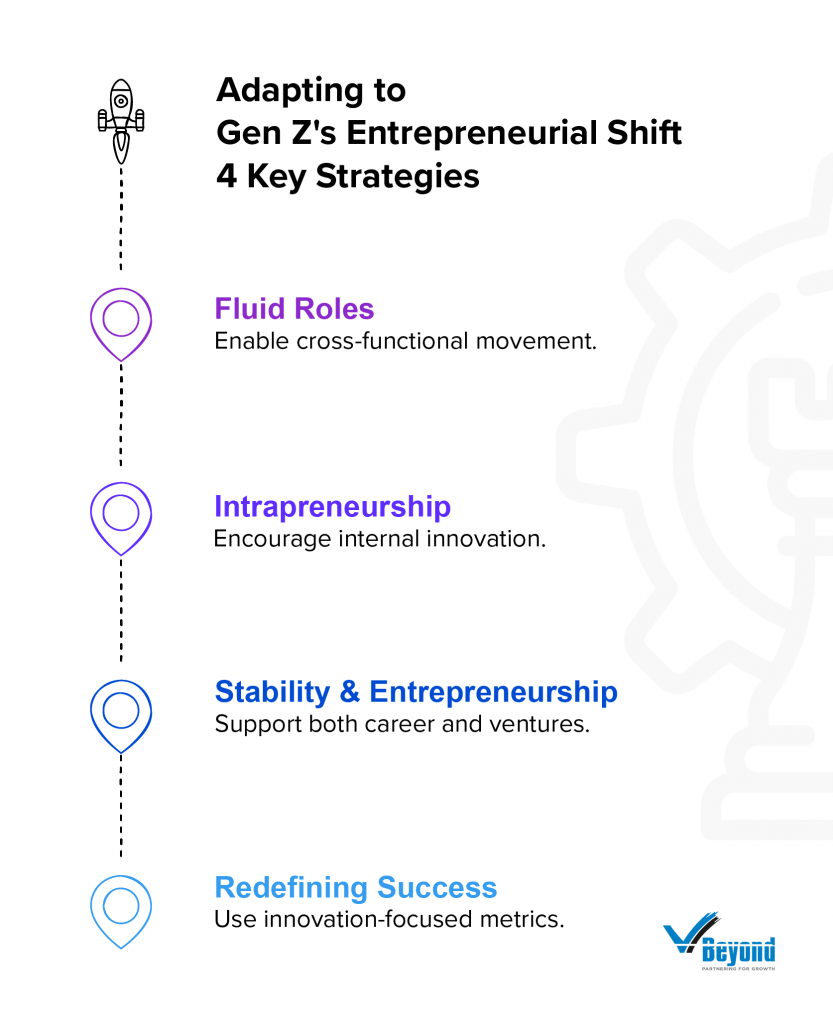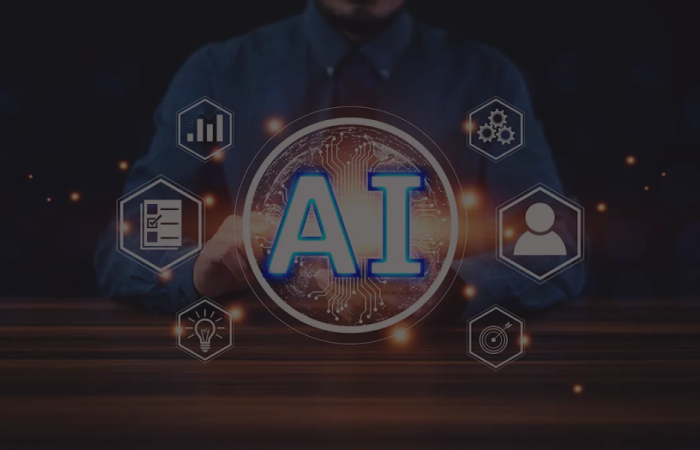Introduction
The career landscape is evolving, driven by a generation that refuses to be boxed in by the traditional 9-to-5 framework. Gen Z entrepreneurship is on the rise, with this youngest cohort entering the workforce; this is challenging the Gen Z hiring trends that conventional career paths once followed.
Gen Z aspirations lean heavily toward independence, flexibility, and entrepreneurship. The idea of long-term loyalty to one employer is fading fast, replaced by a desire to carve out individual success on their own terms. For recruiters and employers, this shift isn’t just an emerging trend—it’s a fundamental transformation that will shape the future of work.
Gen Z’s Entrepreneurial Mindset: The Catalyst for a New Work Era
Could Independent Thinking Redefine Future Gen Z Employment?
A recent poll by Santander UK in September 2024 paints a clear picture of emerging Gen Z entrepreneurship. Three-quarters of Gen Z respondents stated that they aim to be their own boss, shunning the idea of settling into long-term employment with established firms. This isn’t just idle ambition either—77% of those surveyed expressed confidence in their ability to successfully start and run a business, with nearly 40% believing they could manage it solely through their smartphones. The reliance on digital tools underscores the unique position Gen Z occupies. They’ve grown up in the digital age, with instant access to information, tools, and global connections. Their comfort with technology isn’t a mere advantage; it’s a fundamental part of their approach to work and entrepreneurship.
The findings also reveal a stark generational divide in how entrepreneurship is perceived. While 50% of Gen Z and millennials feel they have an edge due to their digital upbringing, only 34% of Generation X and Baby Boomers share that sentiment. Many older respondents felt that societal pressures limited their opportunities to explore entrepreneurial ventures in their early careers. In contrast, Gen Z sees fewer barriers, buoyed by a digital ecosystem that fosters innovation, agility, and rapid execution. This shift is already apparent in real-world outcomes: two-thirds of the 850 businesses applying for Santander’s entrepreneurial awards this year were founded by Gen Z entrepreneurs. These ventures span diverse sectors like healthcare, AI, sustainability, and technology, underscoring the wide-reaching impact of this entrepreneurial wave
Rethinking Work: Four Strategies to Adapt to Gen Z’s Entrepreneurial Drive
Recently, we’ve been observing a noticeable shift in the workforce, particularly with Gen Z moving away from traditional tech jobs, as we explored [read our blog: Beyond Silicon Valley: How Gen Z Career Trends Could Reshape Recruitment]. Now, new findings from Santander further emphasize this changing tide, showing that an increasing number of young professionals are gravitating towards entrepreneurship. These evolving career aspirations indicate something deeper—Gen Z isn’t merely stepping away from established industries; they’re actively seeking autonomy and innovation, preferring to create something of their own. The new wave of Gen Z entrepreneurship challenges us to rethink not just how we manage talent, but how we structure employment models to meet the needs of a generation driven by independence and flexibility.

1. Fluid Roles: The Key to Attracting a Flexible Workforce
Why Dynamic Job Structures Are More Appealing for Gen Z Employment?
Gen Z’s desire for autonomy and variety means that traditional, rigid job descriptions no longer hold appeal. They want roles that allow them to grow and shift dynamically—not just vertically, but laterally across departments and functions. This is about giving employees the chance to move fluidly within the organization, adapting their roles based on changing business needs and their own evolving interests.
Fluid roles break the mold of static positions, offering flexibility in task scope and responsibilities. Employees can move between projects, contribute to multiple areas of the business, and take on new challenges as they develop skills and insights. As part of this flexibility, mentorship becomes crucial: employees can receive guidance not only from a single leader but from multiple mentors across different areas, helping them build a broad skillset and develop cross-functional knowledge.
This model of fluid roles can also serve as a preparation for future leadership positions. By moving across departments and working on a variety of projects, Gen Z employees gain a holistic view of the business, making them more versatile and better equipped for senior roles down the line. This flexibility, paired with mentorship programs, creates a powerful environment where employees are constantly learning, evolving, and being groomed for leadership opportunities.
2. Intrapreneurship: A Platform for Innovation Ownership
Can Companies Cultivate Entrepreneurs Without Losing Them?
While fluid roles provide the structural flexibility Gen Z craves, intrapreneurship takes it a step further by giving them the chance to act as entrepreneurs within the organization. This isn’t just about moving between tasks or departments; it’s about giving employees the opportunity to create and lead their own ventures—whether that’s launching a new product, driving innovation, or solving critical business challenges.
In this context, mentorship plays an essential role in helping these intrapreneurs navigate the complexities of leadership. Since they are taking on entrepreneurial responsibilities within the company, having senior mentors or innovation-focused leaders guiding them can be the difference between success and failure. These mentors can help intrapreneurs refine their business strategies, manage resources, and navigate internal politics, all while fostering the entrepreneurial mindset within a corporate structure.
Furthermore, intrapreneurship serves as a natural pathway to leadership roles. By allowing Gen Z employees to take full control of innovation projects and lead new initiatives, companies are preparing them for future executive positions. These high-impact projects offer the chance to demonstrate leadership potential, making it clear who can handle the responsibilities of managing larger teams or even entire business units in the future—a critical factor in attracting Gen Z talent.
3. Stability Meets Entrepreneurship: Balancing Career and Personal Ventures
How Can Employers Support Gen Z’s Dual Ambitions?
As more Gen Z professionals embrace entrepreneurship, they seek roles that provide stability but also allow them to pursue their own ventures. It’s not enough for companies to offer flexible work arrangements or remote options to attract Gen Z talent—what’s needed is a model that recognizes and supports their dual ambitions: excelling in a full-time role while pursuing entrepreneurial projects.
To strike this balance, companies can provide more structured support for entrepreneurial exploration. For instance, offering learning resources, access to professional networks, or internal coaching can help employees develop the skills they need to succeed both within the company and in their independent projects. This could include business strategy workshops or seminars on topics like funding and scaling, delivered through the lens of corporate development. These are subtle but powerful ways to nurture their entrepreneurial side without taking them away from the core business.
Additionally, companies can build a culture that encourages transparency and collaboration around entrepreneurial interests. Rather than employees feeling they need to keep their side ventures hidden, they should feel comfortable sharing their projects with leadership—especially when those skills or insights can directly benefit the company. This open dialogue allows employees to feel trusted and supported in their ventures while staying fully committed to their role.
Finally, clarity around boundaries is essential. Companies must set clear expectations, ensuring that entrepreneurial ventures do not interfere with performance or productivity. By fostering this balance—providing the resources and trust employees need while maintaining clarity on job priorities—organizations create a win-win model that keeps entrepreneurial minds engaged while meeting business goals.
4. Redefining Success: New Metrics for an Entrepreneurial Workforce
How Can We Measure Performance in a Non-Linear Career Path?
As the line between entrepreneurship and employment blurs, measuring the performance of this hybrid workforce requires moving beyond conventional metrics. From job descriptions to onboarding and performance reviews, we need to adopt a more dynamic and non-linear approach—one that values entrepreneurial instincts, adaptive thinking, and the ability to innovate across functions.
Start with the job description, not as a static document but as a living contract that evolves as the employee grows. Rather than listing tasks, organizations can provide employees with broad objectives—not dissimilar to venture milestones—allowing them to define their own path toward achieving them. Employees could be tasked with identifying emerging problems within the company and proposing solutions, or even given the freedom to define new markets or business lines the company hasn’t yet explored. This approach flips the performance evaluation process on its head: the employee is responsible not just for executing but for identifying and prioritizing opportunities.
The recruitment process can also shift from skill matching to auditioning entrepreneurial potential, reflecting evolving Gen Z hiring trends. Instead of traditional interviews, candidates could be asked to develop a mini business plan or a proposal for a project they’d like to implement within the company. This could include new product ideas, operational innovations, or even potential partnerships. This method not only assesses their strategic thinking and risk-taking ability, but also gives insight into whether the candidate views their role as an opportunity to drive value beyond their assigned responsibilities. Candidates could even pitch these ideas to a panel of cross-functional leaders, simulating a real-world entrepreneurial scenario.
Once onboarded, performance evaluation must embrace entrepreneurial metrics. Companies could adopt a system akin to how venture capitalists evaluate startups: looking at the long-term impact of employees’ initiatives, the risks they took, and the innovations they proposed, even if all of them didn’t succeed. Failure should be seen as a learning metric, with employees evaluated on their ability to iterate and learn from setbacks rather than just their immediate success rate. A quarterly or annual innovation report card could be introduced, assessing employees on idea generation, cross-functional collaboration, and the ability to push the organization into new territory, rather than merely checking off performance targets.
Additionally, the onboarding and mentorship process should mirror the startup world, where seasoned mentors work closely with new talent not to fit them into existing molds but to help them carve out new paths within the organization. Mentorship programs that evolve into co-creation partnerships—where the mentor and employee work on new business opportunities together—could revolutionize the way companies integrate entrepreneurial talent
The Challenges Ahead: Can Organizations Keep Up with the Changing Workforce?
Is the Entrepreneurial Spirit a Double-Edged Sword for Employers?
The rise of entrepreneurial exploration within stable employment represents a seismic shift in how we define work—and underscores the fluidity of today’s workforce. Employees are seeking to balance multiple professional personas—as employees, entrepreneurs, creators, and innovators. The blending of professional and personal ambitions fundamentally challenges traditional employment models, with the concept of a “career path” becoming increasingly multidirectional. Skills, projects, and experiences now interweave across roles, creating a workforce that is driven less by linear advancement and more by exploratory, non-linear growth.
However, with this fluidity come significant workforce challenges. As employees strive to balance entrepreneurial ambitions with their full-time roles, the demands of managing both identities often stretch the boundaries of loyalty, focus, and commitment. Many organizations are finding it difficult to retain entrepreneurial talent without compromising on performance and productivity. Employees, on one hand, are drawn to the stability that traditional employment offers, yet they are equally attracted to the autonomy and freedom of entrepreneurial ventures. This friction creates a workforce environment that is both dynamic and unpredictable—dynamic because it unlocks a level of creativity and innovation previously untapped, but unpredictable because the traditional benchmarks of engagement, commitment, and productivity are shifting.
The Big Stay (read our blog The Big Stay Challenge – Strategies to Address Recruitment and Talent Management), where employees are opting to remain in their current roles due to concerns about job security, inflation, and economic uncertainty, complicates the entrepreneurial trend even further. As more individuals stay in stable roles rather than taking risks on new jobs or ventures, companies may initially benefit from lower attrition rates. However, this scenario also raises a critical question: if a significant portion of the workforce is hesitant to leave their roles for entrepreneurial ventures, how sustainable is the entrepreneurial ambition that many claim to have? Can organizations truly accommodate the entrepreneurial aspirations of a workforce that is also driven by a desire for stability?
The tension between staying put and wanting to explore creates a complex environment for businesses. The result could be an over-reliance on entrepreneurial freedom within the organization itself—pushing companies to accommodate this ambition internally or face the risk of workforce dissatisfaction. Additionally, if too many employees pursue entrepreneurial ventures while holding onto stable employment, companies may find themselves with a bifurcated workforce: employees who are physically present but mentally focused on their external ventures, leading to reduced engagement and productivity.
Conclusion: Are You Ready for the Future of Work?
Why Companies Must Evolve or Risk Falling Behind
Waves like these pose an array of pressing questions pertaining to future workforce trends and workforce challenges. How well do we truly understand our workforce’s generational dynamics and aspirations? Are our current policies and organizational structures aligned with the evolving needs of a diverse, multigenerational team?
The challenge lies in segmenting the workforce not just by age, but by values and motivations, and then designing strategies that resonate across these segments.
This paradigm shift demands a new level of strategic thinking—one that is agile, nuanced, and deeply attuned to the changing landscape of work. Employers must reimagine talent management and craft policies that are as dynamic as the workforce itself.
The pivotal question remains: Are you prepared to delve into these complexities and adapt your approach, or will you be left behind as the next generation reshapes the future of work without you? (Read 3 whitepapers on the Future of Work by our executive search brand Vantedge Search)
Ready to attract top Gen Z talent? As the workforce shifts towards entrepreneurship and flexibility, your recruitment strategy needs to evolve. Let us help you find innovative, driven candidates who align with the future of work. Contact us today to build a team that thrives!


